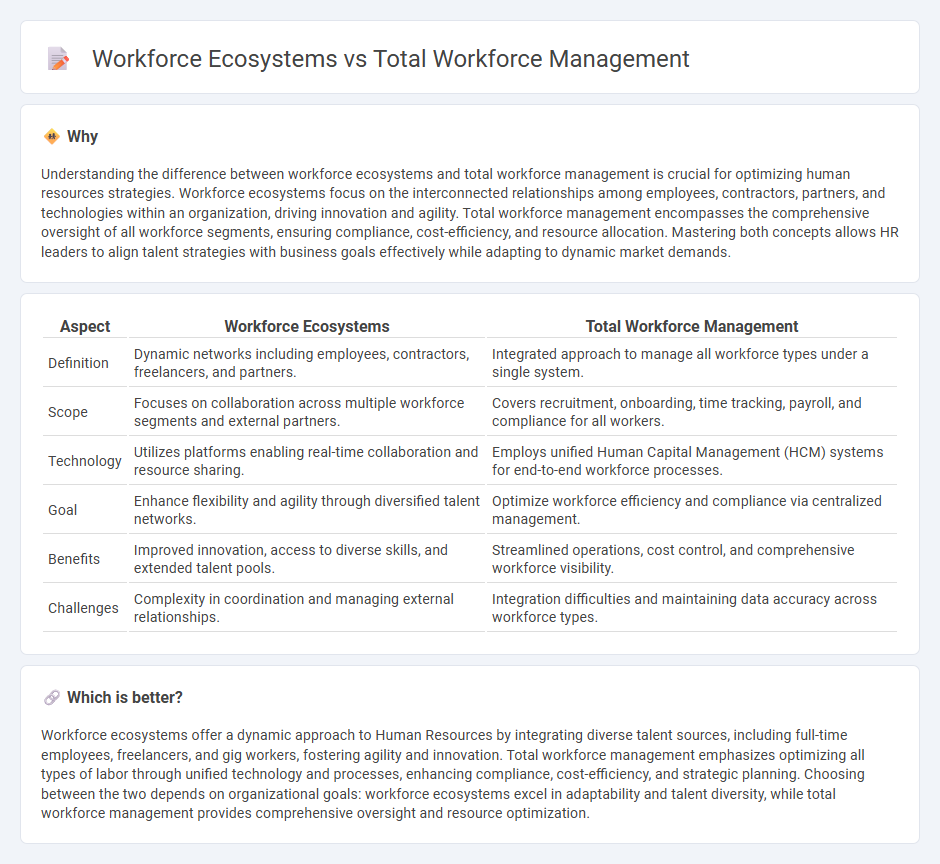
Workforce ecosystems expand traditional human resources by integrating diverse work arrangements, including freelancers, contractors, and gig workers, alongside full-time employees to create a dynamic talent network. Total workforce management focuses on optimizing the entire labor pool through strategic planning, technology, and analytics to enhance productivity and cost efficiency. Explore how these approaches reshape workforce strategies and drive organizational success.
Why it is important
Understanding the difference between workforce ecosystems and total workforce management is crucial for optimizing human resources strategies. Workforce ecosystems focus on the interconnected relationships among employees, contractors, partners, and technologies within an organization, driving innovation and agility. Total workforce management encompasses the comprehensive oversight of all workforce segments, ensuring compliance, cost-efficiency, and resource allocation. Mastering both concepts allows HR leaders to align talent strategies with business goals effectively while adapting to dynamic market demands.
Comparison Table
| Aspect | Workforce Ecosystems | Total Workforce Management |
|---|---|---|
| Definition | Dynamic networks including employees, contractors, freelancers, and partners. | Integrated approach to manage all workforce types under a single system. |
| Scope | Focuses on collaboration across multiple workforce segments and external partners. | Covers recruitment, onboarding, time tracking, payroll, and compliance for all workers. |
| Technology | Utilizes platforms enabling real-time collaboration and resource sharing. | Employs unified Human Capital Management (HCM) systems for end-to-end workforce processes. |
| Goal | Enhance flexibility and agility through diversified talent networks. | Optimize workforce efficiency and compliance via centralized management. |
| Benefits | Improved innovation, access to diverse skills, and extended talent pools. | Streamlined operations, cost control, and comprehensive workforce visibility. |
| Challenges | Complexity in coordination and managing external relationships. | Integration difficulties and maintaining data accuracy across workforce types. |
Which is better?
Workforce ecosystems offer a dynamic approach to Human Resources by integrating diverse talent sources, including full-time employees, freelancers, and gig workers, fostering agility and innovation. Total workforce management emphasizes optimizing all types of labor through unified technology and processes, enhancing compliance, cost-efficiency, and strategic planning. Choosing between the two depends on organizational goals: workforce ecosystems excel in adaptability and talent diversity, while total workforce management provides comprehensive oversight and resource optimization.
Connection
Workforce ecosystems integrate diverse labor segments including full-time employees, freelancers, and contractors, creating a dynamic environment that total workforce management aims to optimize. Total workforce management leverages data analytics and strategic planning to align all workforce components, enhancing productivity and reducing costs. This holistic approach enables businesses to adapt quickly to market changes while maintaining a flexible and engaged talent pool.
Key Terms
**Total Workforce Management:**
Total Workforce Management (TWM) centralizes the planning, recruitment, development, and retention of all employee types, including full-time, part-time, and contingent workers, ensuring optimized labor costs and enhanced productivity. It integrates data analytics, compliance tracking, and talent management systems to deliver a seamless and strategic workforce approach. Explore in-depth insights on how Total Workforce Management transforms organizational efficiency and competitiveness.
Talent Acquisition
Total workforce management integrates permanent, contingent, and freelance workers under a unified strategy, optimizing talent acquisition by centralizing recruitment, onboarding, and workforce analytics. Workforce ecosystems extend beyond internal employees to include external partners, technology platforms, and gig workers, enabling companies to access diverse talent pools and enhance agility in hiring. Explore how leveraging these approaches transforms talent acquisition for competitive advantage.
Workforce Planning
Total workforce management integrates all types of labor--full-time, part-time, contractors, freelancers--into a unified strategy, emphasizing comprehensive workforce planning to balance demand, skills, and costs. Workforce ecosystems extend beyond internal management by including external partners, technology platforms, and talent marketplaces, creating agile, scalable environments that adapt quickly to changing business needs. Explore how both approaches enhance workforce planning to align talent strategy with organizational goals.
Source and External Links
What is Total Workforce Management? - Tech Talent Partners - Total Workforce Management (TWM) is a strategy and integrated software system that combines management of both full-time and contingent workers to enable data-driven hiring, onboarding, performance, remuneration, and succession planning decisions across an entire workforce.
Total Talent Management | Workday US - Total Workforce Management integrates full-time employee and contingent labor management through technology like Workday HCM and VNDLY VMS, improving agility, compliance, hiring, and cost optimization by providing a unified, total workforce view.
SAP's Total Workforce Management framework - PwC - PwC's Total Workforce Management solution harmonizes processes and systems for comprehensive workforce visibility, automated compliance, cost reduction, and talent optimization through integrated digital transformation.
 dowidth.com
dowidth.com